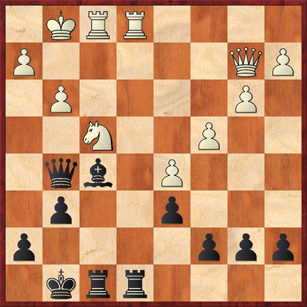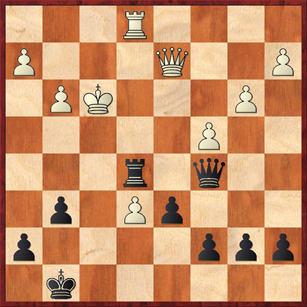Last night I went to chess club at Borders, for the first time since they moved their closing time to an hour earlier. This change has forced us to speed up the time controls, so that we now play three 15-minute games instead of three 25-minute games. From what I was told, the reduced hours are Borders’ response to competition from Barnes and Noble. Let’s see … You decrease service and frustrate both your employees and your customers. Some may call that “competition.” I would call it “shooting yourself in the foot.” But what do I know?
Two people at chess club mentioned that they read my blog. Thanks! The funny thing is that I knew about my international readers in France and Spain and Denmark, but I didn’t know about the readers in my own hometown! This blog entry is for you.
Last night we had a good turnout and a stronger than usual top quad, with four experts — Juande Perea, Rich Flacco, Dan Burkhard, and me. I wasn’t expecting to do too well, because I consider game/15 to be speed chess and I’m not usually very good at speed chess. But actually, I did better than expected. I beat both Rich and Juande. The games weren’t all that interesting, because I used the oldest strategy in the books: snatch a pawn, snatch another pawn, push the extra pawns and win. This doesn’t always work, because Juande and Rich aren’t usually in the habit of hanging pawns. But this was 15-minute chess, and I guess that affected their play as well as mine.
Rich, by the way, has returned after an absence of several years from the Santa Cruz chess scene. It’s great to see him back. He said that for the last few months he was in India, but he came back because he “couldn’t take it any more.” I think that his “it” meant two things: (a) the disparity in wealth between rich and poor, and (b) the assumption that because you’re a foreigner, you are rich and can therefore be charged more for everything.
My third game, against Dan, was the most interesting one. We got to this position, where White has a slight space advantage and a better minor piece, but Black entertains some vague hopes of attacking on the kingside. (He was White, I was Black.)
Here Dan played 22. Ne6, which I would call Typical Speed Chess Mistake #1 in this game. In tournament chess you can (and should)Â take your time and prepare a move like this, but in speed chess the philosophy tends to be, “Full speed ahead and damn the torpedos.” Dan is attracted by the idea of creating an advanced passed pawn on e6, but he neglects to consider the open lines and attacking chances this will give to Black. Better would have been 22. Qd4, which not only “tickles” the pawn on a7 but also controls the a7-g1 diagonal, which turns out to be important.
After 22. Ne6 I played 22. … Bxe6, of course, and the game continued 23. Rxf8+ Rxf8 24. de Qc5+ 25. Kg2 Qc6+ 26. Kh3?!
Yikes! Another speed chess mistake. He should just play 26. Kg1 and agree to a draw by repetition. Dan is still underestimating the danger to his king. Only after I played 26. … Rf5! did he realize that he is in danger of getting checkmated. As it turns out, the computer says that his best and only move to draw here is 27. e7, but that looked too scary, and so he played 27. Qe2? Rh5+ 28. Kg4 Qc5 29. Kf3 Re5 30. Qd2.
The computer says that I have played the last nine moves perfectly, which is somewhat surprising considering how complicated the position was and considering the fact that I had less than two minutes left. Here, however, I missed the obvious combination to win a pawn. Do you see it?
This was Typical Speed Chess Mistake #2: Tunnel vision. I believe that the reason I missed this was that I was focused completely on either checkmating him or getting a perpetual check. The pawn on e6, on the other hand, had seemed securely defended, so I had dismissed from my mind any possibility of winning it.
As you probably see by now, the correct move is 30. … Rxe6! 31. Rxe6 Qf5+. It’s not clear that Black will win here — with less than two minutes on my clock and less than three minutes on his, anything could happen — but a pawn-up endgame with no significant weaknesses is much better than Black could have hoped for in our initial position.
Instead I played 30. … Qc6+? 31. Kg4 Re4+ 32. Kh3 Rxe1 33. Qxe1 Qe8, and White’s obnoxious pawn on e6 has been allowed to live. Black might still be able to draw this position with careful defense, but with so little time left on my clock I was not up to it, and I lost.




